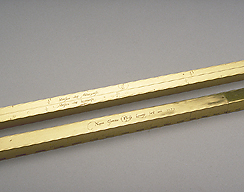
 |
| Catalogue |
 |
 Cross-staff Three sides of the rod are engraved as follows: 1) A non-linear scale marked 'Partes inaequales' from 13? to 90?, numbered by 1? from 13 to 35, then by 5?, with gradually fewer subdivisions. The supposed position of the cross bar is indicated with an arrow and marked as 'Locus status Transversar?'. 2) A linear scale marked 'Partes aequales' from 0? to 44?, numbered by 1? from 1 to 10, then by 5?, divided to 1/2 and 1/10. 3) Two linear scales for the ell of Antwerp and the ell of Louvain respectively: a) marked 'Mensura ulnae Antverpiensis' with a full length of 694 mm with markings for 1/16, 1/8,Z, 1/4, 3/8, 1/2, 5/8, 3/4, 7/8; b) marked 'Mensura ulnae Louaniensis' with a full length of 678 mm with markings for 1/16, 1/8, Z, 1/4, 3/8, 1/2, 5/8, 3/4, 7/8, 15/16. The signature of the maker and the date are given as 'Nepos Gemmae Phrisy Louan? an<n> 1571'. The signature 'nephew of Gemma Frisius' used to be attributed to two separate makers Gualterius and Regnerus Arsenius, but recent research has shown that there is in fact only one person who used both names. The instrument was presented by Rev. Arthur W. Phelps in 1886 and is described in F. A. B. Ward, A Catalogue of European Scientific Instruments in the Department of Medieval and Later Antiquities of the British Museum (London, 1981), p. 98, no. 288. Silke Ackermann |



